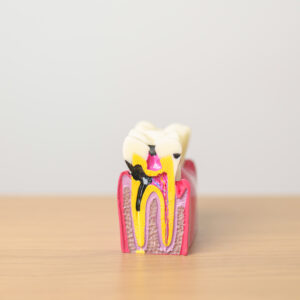Root Canals: A Simple And Easy Guide For Patients
If your dentist has mentioned that you need a root canal, you might feel a bit nervous. The good news is that a root canal is a standard and safe procedure that can save your tooth, relieve pain, and prevent future problems.
Here’s a breakdown of a root canal: what to expect.
What is a Root Canal?
Inside each tooth, there’s a soft area called the *pulp*, which contains nerves and blood vessels. If the pulp gets infected or inflamed (usually from deep decay, cracks, or injury), it can cause much pain. This infection won’t go away on its own, and if left untreated, it can lead to more severe issues like abscesses (painful pockets of infection).
A root canal is a treatment that removes the infected pulp, cleans the area, and seals the tooth so that the pain goes away and you can keep your natural tooth.
Why Do I Need a Root Canal?
You may need a root canal if you have:
– Severe tooth pain, especially when chewing or putting pressure on the area
– Sensitivity to hot or cold that lingers
– Swollen gums around a specific tooth
– Darkening or discoloration of a tooth
If you’re experiencing any of these symptoms, it’s a sign that the pulp inside the tooth might be infected or damaged.
What Happens During a Root Canal?
1. Numbing the Area: Your dentist will start by numbing your tooth and the surrounding area so you won’t feel any pain during the procedure.
2. Cleaning Out the Infection: Once you’re comfortable, the dentist makes a small opening in the top of the tooth to access the infected pulp. Then, they carefully remove the pulp, clean the inside of the tooth, and shape the canal to prepare it for sealing.
3. Sealing the Tooth: After the inside of the tooth is cleaned and dried, it’s sealed to prevent future infections. Sometimes, a temporary filling is placed first, and a permanent filling or crown is put on in a later visit.
4. Restoring the Tooth: Since a root canal can make a tooth more fragile, your dentist may place a crown on top of the treated tooth to protect it. This crown helps the tooth stay strong so you can chew and smile like usual.
Does a Root Canal Hurt?
A root canal relieves pain by removing the source of infection or inflammation causing the discomfort. Modern dental techniques and anesthesia mean that root canals are no more uncomfortable than getting a regular filling. Most patients feel much better afterward and are glad to be free of the pain they are experiencing.
What Happens After the Root Canal?
After the procedure, your tooth and gums may feel slightly sore, but this should go away within a few days. You can manage any discomfort with over-the-counter pain relievers as your dentist recommends. It’s best to avoid chewing on that side until your dentist places a crown or permanent filling to protect the tooth entirely.
Benefits of a Root Canal
Relieves Pain: A root canal removes the infection, causing pain and discomfort.
Saves Your Tooth: Instead of extracting the tooth, a root canal allows you to keep your natural tooth.
Restores Normal Function: A root canal and a crown will allow you to chew and bite comfortably again.
In short, a root canal is a safe, effective way to save a tooth and relieve pain. If your dentist recommends one, rest assured that it’s a standard procedure with a high success rate. Afterward, you’ll be on your way to a healthier, pain-free smile!


